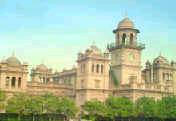|
|
|









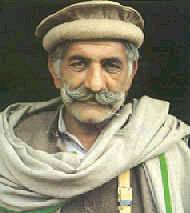
BY SENIOR VICE PRESEDENT (LSWTI)
SYED
SALMAN MEHDI RIZVI
E-mail: lotustrust@hotmail.com
HISTORY OF N.W.F.P
Pakistan's northern and western borders with China and Afghanistan are marked out by rugged hills and mountains ranging in height from 2,000 feet (609 meters) in the south-west to over 28,000 feet (8,535 meters) in the far north. The gateways through this otherwise unbroken barrier are occasional natural passes. By far the best-known of these is the Khyber Pass, which is 56 kilometers long, 40 kilometers being in Pakistan and the remainder in Afghanistan. From the Khyber border post at Torkham, where an old sign warns hitch-hikers that under no circumstances should they spend the night in the open in the Pass, it is a 55 kilometer journey to the city of Peshawar. Pakistan's capital, Islamabad, is 227 kilometers away, Lahore 497 kilometers, and the port of Karachi 1,782 kilometers.

A typical pathan
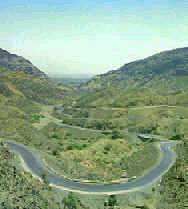
Khyber Pass
Khyber Pass
Since ancient times the Khyber has formed a vital route for overland trade between Pakistan and Afghanistan, and a point of entry to the subcontinent for invading armies. Its military importance is easily explained. It is wide enough to allow troops and cavalry to march through it in disciplined ranks and its highest point, Landi Kotal, is only 3,500 feet (1067 meters) above sea-level. Beyond the Pass, beckoning enticingly to the greedy and the bold, lies the lush Vale of Peshawar at the head of the rich and fertile Indus Valley.
In the fourth century BC, when Alexander the Great of Macedon invaded the Punjab, one of his divisions came through the Khyber. In the tenth century AD Sabuktigin, who founded the Ghaznivid dynasty, and his more famous son Mahmud, brought their armies through the Pass on their way to the conquest of much of Pakistan and northern India. There is evidence that Genghis Khan and Timurlane made use of the Pass in the thirteenth and fourteenth centuries. Babur, the first of the Mughals, also took this route on his march down into the subcontinent from Afghanistan in 1525. Rather more than 200 years later the Turk Nadir Shah came the same way during the sunset of Mughal rule.
What may at first be surprising is that more of the subcontinent's invaders did not use the Khyber Pass and that those who used it once rarely did so again. The explanation, however, is to be found in the warlike nature of the Afridi tribesmen who have lived in the Pass for rnillennia and have often made war or extracted tolls from those who have tried to use it as a thoroughfare. The Greek historian Herodotus, who wrote in the fifth century BC, knew them as the Aparutai and commented on their bravery. Many others since then have noted their readiness to fight. Sir Robert Warburton, a British army-officer who spent several years with the garrisons in the Khyber in the late nineteenth century, had this to say of them: 'The Afridi lad from his earliest childhood is taught by the circumstances of his existence and life to distrust all mankind, and very often his near relations, heirs to his small plot of land by right of inheritance, are his deadliest enemies."
The British left behind a number of mementos of their long stay in the Khyber. The road itself is the most enduring, while the weathered and faded insignia and crests of famous regiments carved into the glowering slate walls of the Pass are the most evocative. There is a railway too, dating back to the mid1920s. The sight of the steam train which, once a week on Fridays, runs up from Peshawar to Landi Kotal, reinforces the sense that one has of the Khyber Pass being outside the normal processes of time. The train has an engine at either end-both were made in England in I931. Clouds of steam belch forth as it chugs up and down the gradients of the Pass and in and out of the tunnels. As it pulls into the shelter of the massive red-brick walls of Shagai Fort, built in the center of the Khyber at around the same time as the railway, a passenger could be forgiven for thinking that the price of his ticket had taken him not on a journey from place to place but on a journey back into another era.
A stiff climb above Shagai stands an empty picket-fort that commands a sniper's-eye view. The wind blows through its rifle slits and machine-gun turrets and whips under the sill of its heavily- armored iron door, sadly recalling battles of long ago and the lonely soldiers far from home who fought them.
The British first arrived on the frontier in I849, but did not get any real control of the Passes until the Second Afghan War, which was fought between 1878 and 1880. Though there was a curious kind of mutual respect between the British and the tribesmen, real peace was never established in the region. History records that more than forty British military expeditions were obliged to take the field between 1858 and 1902.
HISTORY OF PESHAWAR, THE CAPITAL OF N.W.F.P
Peshawar derives its name from a Sanskrit word "Pushpapura" meaning the city of flowers. Peshawar's flowers were mentioned even in Mughal Emperor Babur's memoirs.
Peshawar is now, as always, very much a frontier town. The formalities of dress and manner give way here to a free and easy style, as men encounter men with a firm hand-clasp and a straight but friendly look. Hefty handsome men in baggy trousers and long, loose shirts, wear bullet studded bandoleers across their chests or pistols at their sides as a normal part of their dress.
There is just that little touch of excitement and drama in the air that makes for a frontier land. An occasional salvo of gun fire-no, not a tribal raid or a skirmish in the streets but a lively part of wedding celebrations.
Remember, we are in the land of the Pathans - a completely male- dominated society. North and south of Peshawar spreads the vast tribal area where lives the biggest tribal society in the world, and the most well- known, though much misrepresented.
Pathans are faithful Muslims. Their typical martial and religious character has been molded by their heroes, like Khushal Khan Khattak, the warrior- poet and Rehman Baba, a preacher and.also a poet of Pushto language.
Peshawar is the great Pathan city. And what a city! Hoary with age and the passage of twenty-five centuries, redolent with the smell of luscious fruit and roasted meat and tobacco smoke, placid and relaxed but pulsating with the rhythmic sound of craftsmen's hammers and horses' hooves, unhurried in its pedestrian pace and horse-carriage traffic, darkened with tall houses, narrow lanes and overhanging balconies, intimate, with its freely intermingling crowd of townsmen, tribals, traders and tourists - this is old Peshawar, the journey's end or at least a long halt, for those travelling up north or coming down from the Middle East or Central Asia, now as centuries before when caravans unloaded in the many caravan serais now lying deserted outside the dismantled city walls or used as garages by the modern caravans of far-ranging buses.
MOSQUE OF MAHABAT KHAN
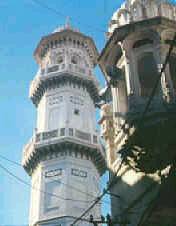
BALAHISAAR FORT
The mighty Balahisaar Fort lies on both eastern and western approaches to Peshawar city. It meets the eye when coming from Rawalpindi or from the Khyber. It is a massive frowning structure as its name implies, and the newcomer passing under the shadow of its huge battlements ramparts cannot fail to be impressed. Originally built by Babur, the 1st of the Moguls in 1526-30, it was rebuilt in its present form by the Sikh Governor of Peshawar, Hari Singh Nalva, in the 1830's under guidance of French engineers. It houses government offices at present.
THE OLD CITY
Until the mid-fifties Peshawar was enclosed within a city wall and sixteen gates. Of the old city gates the most famous was the Kabuli Gate but only the name remains now. It leads out to the Khyber and on to Kabul. You come across two-and-three storied houses built mostly of unbaked bricks set in wooden frames to guard against earthquakes. Many old houses have beautifully carved heavy wooden doors and almost all have highly ornamental wooden balconies. There is a tall and broad structure whose lofty portal look down upon the street. This historic building houses the police offices and the site was occupied centuries ago by a Buddhist stupa, then by a Hindu temple and then by a Mughal serai. It was, in Sikh days, the seat of General Avitable, an Italian soldier of fortune in the service of Ranjit Singh.
PESHAWAR MUSEUM
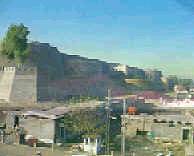 Peshawar Museum is housed in an imposing building of the British days. It
was formerly the Victoria Memorial Hall built in 1905. The large hall, side
galleries and the raised platform which were used for ball dances now display in
chronological order finest specimens of Gandhara sculptures, tribal life, the
Muslim period and ethnography.
Peshawar Museum is housed in an imposing building of the British days. It
was formerly the Victoria Memorial Hall built in 1905. The large hall, side
galleries and the raised platform which were used for ball dances now display in
chronological order finest specimens of Gandhara sculptures, tribal life, the
Muslim period and ethnography.
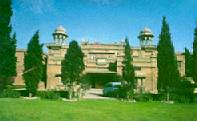
QISSA KHAWANI BAZAAR
Here perhaps visiting travelers or the relaxing townsmen were regaled with stories by professional story tellers, in the evening, in the many tea-shops that still adorn the bazaar front with their large brass samovars and numerous hanging teapots and teacups. As in most eastern bazaars, the shops of delicacies predominate, and here too you will find many colorful fruit shops displaying the glorious harvest of Peshawar's orchards. You will be waylaid by the enticing smell of Peshawar's unrivaled bread and justly celebrated "kababs" and "tikkas" meat sizzling on hot coals, in the many wayside cafes. Leather goods shops are the next most numerous selling that wonderful footwear, the Peshawari "chappals" or sandals, belts, holsters and bandoliers and a special variety of light but sturdy suitcases called "Yakhdaan".
OTHER BAZAARS
As you move up, the Qissa Khawani Bazaar turns left and here begins the bazaar of coppersmiths whose jewel-like engraved and embossed jars, bowls, ewers and plates are piled up in shops like glistening treasure trove. Other famous bazaars of Peshawar are the Khyber Bazaar. Bird Bazaar, Fruit Bazaar, Basket Bazaar, Andershahr Bazaar, Jewelry Bazaar and Meena Bazaar for women and Mochidara (Shoe makers' Bazaar). In fact, the variety of craft in which Peshawar excels even today is amazing and this is a part of the city's character often eclipsed by its martial tradition. Remember that it was in this valley of Peshawar that there flourished that remarkable school of Gandhara sculpture (roughly from 1st century B.C. to the 5th century A.D.), which is one of the glories of Pakistan's heritage.
CHOWK YADGAAR
 Soon you reach the central
square called Chowk Yadgaar the traditional site of political rallies. The two
routes from the old city meet here. Parking of cars can safely be done only at
this place in the old city.
Soon you reach the central
square called Chowk Yadgaar the traditional site of political rallies. The two
routes from the old city meet here. Parking of cars can safely be done only at
this place in the old city.
NEW PESHAWAR
their administrative offices, military barracks, residences, parks, churches' and shops.
The Peshawar "Saddar" (Cantonment) is a spaciously laid out neat and clean township with avenues of tall trees, wide tarred roads, large single-storied houses with lawns and a pervading scent of rare shrubs and flowers that is Peshawar's own.
The heart of the Saddar is the Khalid bin Walid (Company) Bagh which is an old Mughal Garden. Its huge ancient trees and gorgeous big roses are a sight to remember. Two other splendid old gardens are the Shahi Bagh in the north-east and the Wazir Bagh in the south-east, all of which give the character of a garden city to Peshawar.
In the Saddar is the splendid modern State Bank building, Governor's House, hotels, old missionary Edwards College, a richly stocked Museum, a fine shopping area and right in the middle is the Tourist Information Center at Dean's Hotel (Phone: 279781).
Westward, on the road to the Khyber, where in the days gone by, no one was safe from tribal raids, today stretches a long line of educational and research institutions, such as the Academy of Rural Development, the Teachers Training College, the North Regional Laboratories of the Council of Scientific and Industrial Research and many others.
But the pride of Peshawar today is its University, a vast sprawling garden town of red brick buildings and velvet lawns, which comprises a dozen departments and Colleges of Law, Medicine, Engineering and Forestry. Special mention must be made of the Islamia College, which was the pioneer national Institution that ignited the torch of enlightenment in this region, 67 years ago
